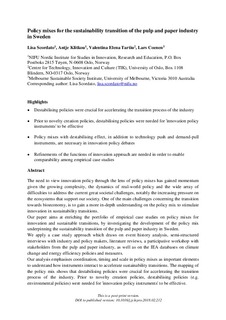| dc.contributor.author | Scordato, Lisa | |
| dc.contributor.author | Klitkou, Antje | |
| dc.contributor.author | Tartiu, Valentina Elena | |
| dc.contributor.author | Coenen, Lars | |
| dc.date.accessioned | 2018-03-07T16:50:44Z | |
| dc.date.available | 2018-03-07T16:50:44Z | |
| dc.date.created | 2018-03-05T15:13:44Z | |
| dc.date.issued | 2018 | |
| dc.identifier.citation | Journal of Cleaner Production. 2018, 183 (May), 1216-1227. | nb_NO |
| dc.identifier.issn | 0959-6526 | |
| dc.identifier.uri | http://hdl.handle.net/11250/2489394 | |
| dc.description.abstract | The need to view innovation policy through the lens of policy mixes has gained momentum given the growing complexity, the dynamics of real-world policy and the wide array of difficulties to address the current great societal challenges, notably the increasing pressure on the ecosystems that support our society. One of the main challenges concerning the transition towards bioeconomy, is to gain a more in-depth understanding on the policy mix to stimulate innovation in sustainability transitions.
Our paper aims at enriching the portfolio of empirical case studies on policy mixes for innovation and sustainable transitions, by investigating the development of the policy mix underpinning the sustainability transition of the pulp and paper industry in Sweden.
We apply a case study approach which draws on event history analysis, semi-structured interviews with industry and policy makers, literature reviews, a participative workshop with stakeholders from the pulp and paper industry, as well as on the IEA databases on climate change and energy efficiency policies and measures.
Our analysis emphasises coordination, timing and scale in policy mixes as important elements to understand how instruments interact to accelerate sustainability transitions. The mapping of the policy mix shows that destabilising policies were crucial for accelerating the transition process of the industry. Prior to novelty creation policies, destabilising policies (e.g. environmental policies) were needed for 'innovation policy instruments' to be effective.
More specific instruments (e.g. carbon tax), targeting particular functions of the innovation systems, require 'on-the-ground' policy intelligence and benefit from close interaction with industry. | nb_NO |
| dc.language.iso | eng | nb_NO |
| dc.subject | Treforedling | nb_NO |
| dc.subject | Pulp and paper | nb_NO |
| dc.subject | Bærekraft | nb_NO |
| dc.subject | Sustainability | nb_NO |
| dc.subject | Grønn politikk | nb_NO |
| dc.subject | Green politics | nb_NO |
| dc.subject | Policy mix | nb_NO |
| dc.subject | Sustainable transition | nb_NO |
| dc.subject | Innovation policy | nb_NO |
| dc.subject | Pulp and paper industry | nb_NO |
| dc.title | Policy mixes for the sustainability transition of the pulp and paper industry in Sweden | nb_NO |
| dc.type | Journal article | nb_NO |
| dc.type | Peer reviewed | nb_NO |
| dc.description.version | acceptedVersion | nb_NO |
| dc.subject.nsi | VDP::Samfunnsvitenskap: 200 | nb_NO |
| dc.subject.nsi | VDP::Social sciences: 200 | nb_NO |
| dc.source.pagenumber | 1216-1227 | nb_NO |
| dc.source.volume | 183 | nb_NO |
| dc.source.journal | Journal of Cleaner Production | nb_NO |
| dc.source.issue | May | nb_NO |
| dc.identifier.doi | 10.1016/j.jclepro.2018.02.212 | |
| dc.identifier.cristin | 1570542 | |
| dc.relation.project | Norges forskningsråd: 485561 | nb_NO |
| cristin.unitcode | 7463,0,0,0 | |
| cristin.unitname | NIFU Nordisk institutt for studier av innovasjon, forskning og utdanning | |
| cristin.ispublished | true | |
| cristin.fulltext | postprint | |
| cristin.qualitycode | 2 | |
